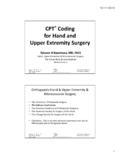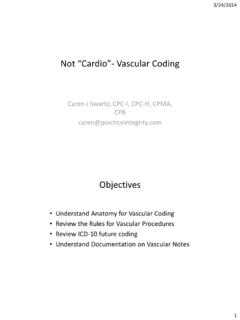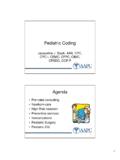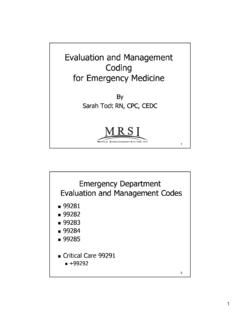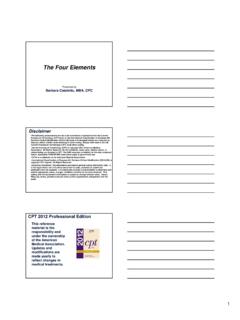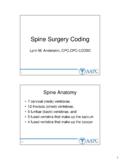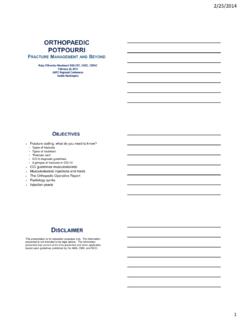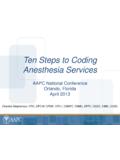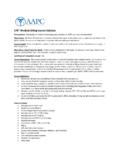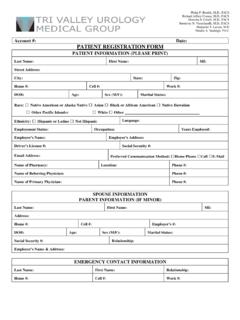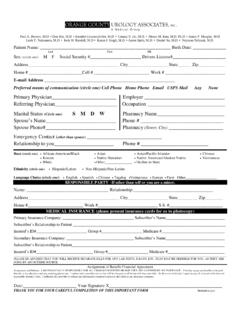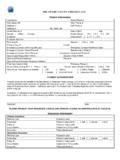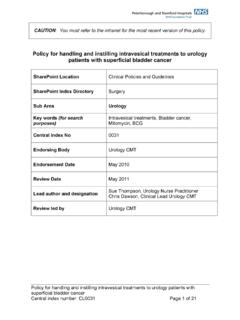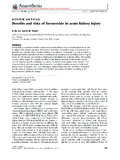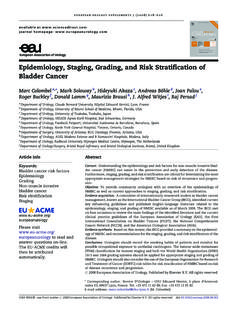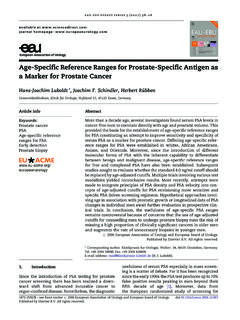Transcription of Specialty Code Set Training Urology - AAPC
1 ICD-10-CMSpecialty code Set TrainingUrology2014 Module 1ii ICD-10-CM Specialty code Set Training Urology 2013 AAPC. All rights course was current at the time it was published. This course was prepared as a tool to assist the participant in understanding how to prepare for ICD-10-CM. Although every reasonable effort has been made to assure the accuracy of the information within these pages, the ultimate responsibility of the use of this information lies with the student. AAPC does not accept responsibility or liability with regard to errors, omissions, misuse, and misinterpretation. AAPC employees, agents, and staff make no representation, warranty, or guarantee that this compilation of information is error-free and will bear no responsibility, or liability for the results or consequences of the use of this does not accept responsibility or liability for any adverse outcome from using this study program for any reason including undetected inaccuracy, opinion, and analysis that might prove erroneous or amended, or the coder s misunderstanding or misapplication of topics.
2 Application of the information in this text does not imply or guarantee claims payment. Inquiries of your local carrier(s) bulletins, policy announcements, etc., should be made to resolve local billing requirements. Payers interpretations may vary from those in this program. Finally, the law, applicable regulations, payers instructions, interpretations, enforcement, etc., may change at any time in any particular manual may not be copied, reproduced, dismantled, quoted, or presented without the expressed written approval of the AAPC and the sources contained within. No part of this publication covered by the copyright herein may be reproduced, stored in a retrieval system or transmitted in any form or by any means (graphically, electronically, or mechanically, including photocopying, recording, or taping) without the expressed written permission from AAPC and the sources contained Examples Used in this BookAAPC believes it is important in Training and testing to reflect as accurate a coding setting as possible to students and examinees.
3 All examples and case studies used in our study guides and exams are actual, redacted office visit and procedure notes donated by AAPC preserve the real world quality of these notes for educational purposes, we have not re-written or edited the notes to the stringent grammatical or stylistic standards found in the text of our products. Some minor changes have been made for clarity or to correct spelling errors originally in the notes, but essentially they are as one would find them in a coding setting. 2013 AAPC2480 South 3850 West, Suite B, Salt Lake City, Utah 84120800-626- code (2633), Fax 801-236-2258, 121713. All rights , CPC-H , CPC-P , CPMA , CPCO , and CPPM are trademarks of AAPC. 2013 AAPC. All rights reserved. iii121713 ICD-10 ExpertsRhonda Buckholtz, CPC, CPMA, CPC-I, CGSC, CPEDC, CENTC, COBGC VP, ICD-10 Training and EducationShelly Cronin, CPC, CPMA, CPC-I, CANPC, CGSC, CGIC, CPPM Director, ICD-10 TrainingBetty Hovey, CPC, CPMA, CPC-I, CPC-H, CPB, CPCD Director, ICD-10 Development and TrainingJackie Stack, CPC, CPB, CPC-I, CEMC, CFPC, CIMC, CPEDC Director, ICD-10 Development and TrainingPeggy Stilley, CPC, CPB, CPMA, CPC-I, COBGC Director, ICD-10 Development and Training Contents Neoplasms/Infections and Other Diseases.
4 1 Neoplasm of Kidney ..1 Neoplasm of Prostate ..3 Neoplasm of Bladder ..4 Neoplasm of Testicles ..5 History of Cancer ..6 Urinary Tract Infections (UTI) and Inflammation ..6 Kidney Disease/Disorders ..8 Hydronephrosis ..8 Chronic Kidney Disease (CKD) ..8 Acute Kidney Failure ..12 2013 AAPC. All rights reserved. 1121713 Neoplasms/Infections and Other DiseasesICD-10-CM chapter 2 contains codes for most benign and malignant neoplasms. To properly code neoplasms, the documentation in the medical record must indicate if the neoplasm is benign, in situ, malignant, or of uncertain histologic behavior. If there is a malignancy, the secondary (metastatic) site should also be reported as it is currently with in ICD-9-CM there is a separate Table of Neoplasms. The codes should be selected from the table. The guidelines in ICD-10-CM ( ) state; If the histology (cell type) of the neoplasm is documented, that term should be referenced first, in the main section of the Index, rather than going immediately to the Neoplasm Table, in order to determine which column in the Neoplasm Table is appropriate.
5 Specific terms include: adenocarcinoma, sarcoma, leiomyoma, and transitional cell , as in ICD-9-CM, the Neoplasm Table is broken down by type (malignant, benign, uncertain, and unspecified) and site. But the sites are much more specific in ICD-10-CM, so there are many more codes available for reporting purposes. The coder needs to be mindful of these additional choices for multiple reasons, including: to ensure that the codes reported to the payer are at the highest level of specificity and to ensure that the correct codes are tracked for research and public health cancers include cancers of the bladder, kidney, prostate, and of KidneyThe kidneys are fist-sized organs whose major function is to remove waste products and excess fluids from the body through urine. Each kidney contains more than one million nephrons, which are microscopic tubules that make urine.
6 The kidneys perform the following functions: Remove waste products, Remove drugs from the body, Balance the body s fluids, Release hormones that regulate blood pressure, Produce an active form of vitamin D that promotes strong, healthy bones, and Control the production of red blood are three distinct portions of the kidney: the renal cortex, the renal medulla, and the renal pelvis. The renal cortex is the reddish, smooth outer portion. The Bowman s capsules are located in the cortex, which serve as a filter to remove organic waste, excess inorganic salts, and water. The renal medulla is the inner portion consisting mostly of collecting tubules (minute canals that secrete, collect, and conduct urine) organized into a group of structures called the renal pyramids. There are 5 18 of these striated triangular structures that comprise the medulla. The renal pelvis is a funnel-shaped basin into which urine is discharged before passing into the ureter, formed by the renal calyces.
7 The renal calyx has two divisions: the minor renal calyx that drains into a larger 2 ICD-10-CM Specialty code Set Training Urology 2013 AAPC. All rights and Other Diseasesmajor renal calyx. The renal calices carry urine from the renal pyramid in the medulla to the renal pelvis for excretion through the capsuleRenal cortexMedulla(pyramid)RenalcolumnMajorca lyxMinor calyxUreterPelvisRenalsinusRenalhilumNep hron Copyright OptumInsight. All rights reservedAccording to the American Cancer Society, renal cancer is among the 10 most common cancers in both men and women. The most common type of kidney cancer is renal cell carcinoma, which starts in the lining of the tubules in the kidney. Other types are renal pelvis cancer and Wilms tumor, which is a type of kidney cancer that develops in children under the age of ICD-10-CM, there are only two categories of codes for kidney cancer, C64 and C65: Malignant neoplasm of right kidney, except renal pelvis; Malignant neoplasm of left kidney, except renal pelvis; Malignant neoplasm of unspecified kidney, except renal pelvis; Malignant neoplasm of right renal pelvis; Malignant neoplasm of left renal pelvis; and Malignant neoplasm of unspecified renal pelvisCategory C65 has an Includes note that states it includes malignant neoplasm of pelviureteric junction, and malignant neoplasm of renal is also a code , , for malignant carcinoid tumor of the kidney.
8 A carcinoid tumor is a low-grade malignant tumor that originates from neuroendocrine cells and is extremely patient presents with abdominal pain. Abdominal CT reveals a X 8 cm mass in the lower pole of the left kidney and a X cm mass in the mid to upper pole of the right kidney. After further testing, the patient is diagnosed with renal cell carcinoma of both kidneys. Malignant neoplasm of right kidney, except renal pelvis Malignant neoplasm of left kidney, except renal pelvisThe other codes for neoplasm of the kidneys are: Secondary malignant neoplasm of kidney and renal pelvis, 2013 AAPC. All rights reserved. 3121713 Neoplasms/Infections and Other Diseases Carcinoma in situ of other urinary organs, Benign neoplasm of kidney, Benign neoplasm of renal pelvis, Neoplasm of uncertain behavior of kidney, Neoplasm of uncertain behavior of renal pelvis, and Neoplasm of unspecified behavior of other genitourinary woman presents with vague discomfort in her right flank and microscopic hematuria.
9 Imaging studies indicate a solid mass in the right renal pelvis. Further diagnostics confirm this to be benign. Benign neoplasm of right renal pelvisNeoplasm of Prostate The prostate is a gland in men that surrounds the urethra. It helps make semen and is about the size of a walnut in a young male, but grows as a man ages. Prostate cancer is common in older men, but rare in men younger than 40. Symptoms include: problems passing urine, like pain, difficulty starting or stopping the stream of urine, or urine dribbling; low back pain; and pain with ejaculation. Prostate cancer is the most common in American men with one out of every 10 men to develop the disease at some point in his contains a limited number of codes for neoplasms of the prostate: C61 Malignant primary, Malignant secondary, Carcinoma in situ, Benign, Uncertain behavior, and Unspecified behavior.
10 There are also codes in the Neoplasm Table under Prostate for the prostatic utricle (Latin for pouch). This is a small, epithelium-lined diverticulum near the prostate that opens into the urethra, and is a rare site for cancer. The Neoplasm Table lists code for primary malignant neoplasm of the utricle. The descriptor of the code is malignant neoplasm of the urethra, as the utricle is not technically part of the prostate. There are also codes in the Table for the utricle (secondary, carcinoma in situ, etc) also code to the 64-year-old man presents with increased frequency, dribbling, and nocturia. He also complains of increasing low back pain. On digital rectal exam, he is noted to have a hard nodule in the right lobe of his prostate and a PSA of A biopsy reveals a high-grade adenocarcinoma. An MRI scan showed bony metastasis to L2 and L3. C61 Malignant neoplasm of prostate Secondary malignant neoplasm of bone4 ICD-10-CM Specialty code Set Training Urology 2013 AAPC.

